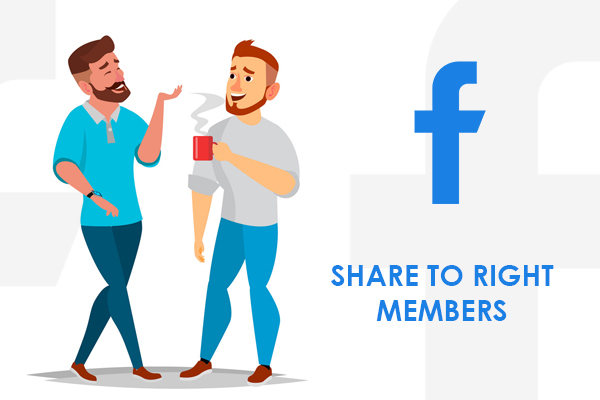The simplest definition for a group is that it’s a community of members with the same interests. Well, you’ll be glad to know that Facebook groups work the same way, just more digital. Most members who make FB groups come and ask how to get more members to your Facebook group?
If you’ve got a Facebook group that you want to fill up with like-minded members, well, then keep reading the article because we’ll be answering this question today.
What Facebook has done for members is magnificent, and it has opened spectacular new prospects as well. Netizens these days are using Facebook groups to first lure the audience and then pitch them services and products in order to get the benefits.
Even brands have got Facebook groups and Facebook pages now and are using them to interact with their audience and bring in more sales and brand awareness. Marketing has become a lot easier since the social media platforms like Facebook have allowed the making of groups and pages.
Currently, there are more than 620 million Facebook groups that are just one Google search away from you. Some of them have millions of members, and others are yet struggling with getting a good enough number on their member’s list.
So, today we’ll talk about some of the tips that we’ve brought for growing your Facebook group and getting more group members. Sit back and enjoy the whole thing because these tactics will surely promote your group.
Table of Contents
How to Get More Facebook Group Members?
So, as always, the tips and tactics that we’ve brought for you are all trusted by social media experts and will make more members join your group if you apply them correctly and continuously.
1. Pick a Successful Name
“Gaming x PUBG” what do you think after reading this name? Exactly! That it’s the name of a gaming group, right? Well, that’s where it all starts, picking a great name for your group. You need to choose a name that resonates with the type of group that you’re looking to make.
If you’re a professional in a specific field, then you got to pick a name that the members interested in that field can relate to. Also, besides keeping your name relatable, it’s also very important to keep it easily searchable and SEO optimized.
Imagine that you’ve given your group a name that has already been used by thousands of other groups. What do you think will happen when someone wants to look up your groups? That’s right! They’ll land on some other group, and they will join that instead of yours.
So, make sure to do your research before you start the process of setting up your Facebook group. The name should be short, relevant, and searchable so that the audience doesn’t feel confused and gets to you easily.
This is one of the simplest and yet most ignored keys for how to get more members to your Facebook group. Better take it seriously than regretting it later.
2. Focus on Your Group Type

There are many reasons why members make groups. Some of them are made just for general fun, and some of them are set up for very specific reasons. It’s very important that you set the direction of your group in the earlier stages so that it’s easy for marketing etc.
Don’t be confused by the word group type. It’s just that on Facebook, the groups are divided into three different classes.
Here are those classes:
- First, there’s a general class. These groups deliver information depending on their orientation. Just search for a specific topic, and you’ll find thousands of general groups on it.
- Second, there are Entertainment groups. It’s pretty clear from the name that these groups deliver entertainment-related data like videos and memes etc.
Then there are product or service groups. These groups are based on a business’ service or its product. The main motive for these groups is to use them for promotion.
Among all these classes, find out which one of the classes your group falls in and then stick to that. Create the content according to that and stick to the field.
3. Complete Your Facebook Group
Sure, you can expect members to come in and join your group, but first of all, you need to complete your Facebook group. What does that mean? Well, it simply means to fill out all the basic information and then moving to some professional stuff that can help you out.
It all starts with a group description. The description should be concise and should describe the purpose of the group in the best way. You can also mention group rules there so that members know what kind of conversations they can have there and what content to expect.
Next is adding a cover photo. Some members don’t take this task very seriously and just put a lousy image that gives off a bad vibe, and that’s definitely not what we want. So, make sure to add an image that is related to your group.
Then there are some advanced things like adding tags to help members find you, adding your location, and customizing your URL. All of these will help you out in the long run to get more members in your groups.
4. Optimize Your Group Settings

You can consider this step as the grand finale for completing group info. If you set up everything right and mess this step, then you won’t find the answer for how to get more members to your Facebook group. So, pay attention.
Groups are either private, public, or are related to only a few members. It’s you who will decide what should be the type. If you want more group members, then you should definitely keep your group open so that members can find it easily and become members.
5. Post Regularly
Consistency is important in life, but it’s a matter of life or death when it comes to social media. Why is that? Let’s see. Assume that you’ve managed to woo a hundred members, and they have joined your group. Now, you’re posting once in a blue moon. What will happen?
They will leave, obviously, because they are not getting the content regularly. So, it’s very important that it remains constant. Content calendars can help you with setting exact times and dates for posting so that your audience is always engaged and keeps getting new content.
6. Share to Right Members

It won’t work out well if you start pitching designing ideas to real estate agents, right? That’s the same thing as marketing your group to the wrong audience. If you’re trying to attract members to join your group, then make sure to share your group with the right members.
People you think might be interested in the type of group you’re leading or the type of content you’re posting need to know that you’ve set a group. So, make sure to share your group with the right members so that your group becomes an engaged Facebook group.
7. Monitor Your Insights
This might be a bit technical for some members, but it sure helps you a lot. Insights are basic stats that tell you which of your posts did well and which were not so much hit according to the audience. You can watch them and decide what to post next.
Most members use it once and adjust the course for never coming back to check it again, which is a huge mistake. You should keep checking with it because the interests of the audience change over time, and that’s why you need to keep evolving your content as well.
This step is also an important answer for how to get more members to your Facebook group, so mention your group and get insights for it as soon as you can.
8. Share on Other Social Media

If you’ve got social media handles, then it’s time to use them for marketing. You can use Facebook, Instagram, or even linkedin social media to share the link for your Facebook group so that more members can join as soon as you start getting more exposure.
9. Link Your Facebook Page
Let’s just say that you’ve got a Facebook page that is doing very well. Now, what you can do is that divert that traffic towards your group by linking it to your Facebook group. People will see your page there, and not only will you get more members but also more page likes.
10. Buy Facebook Group Members

It’s not your fault if you feel tired of trying after some time because it really is hard to engage the audience. The number of groups is increasing, and hence is the competition, so if you feel like you’re not getting results, then buy Facebook group members from GetAFollower.
From GetAFollower, you can get a bunch of Facebook groups members at a very reasonable price. We have delivered millions of group members to our thousands of satisfied customers all over the world. So take a sip of success and join GetAFollower today.
Conclusion
With 620 million groups and more coming every day, you need to stay on your toes to get more group members and be successful. We hope you got the answer to how to get more members to your Facebook group. Stay with us for more helpful tactics and tricks.






